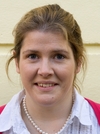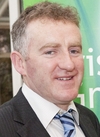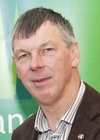The Irish Grassland Associations’ annual Dairy Conference took place in two venues this year, Navan on Tuesday 11th January (a 1/2 day conference) and Cork on Wednesday 12th January. This is in response to the surge in membership that the association has enjoyed in the past 2 years, especially in the Northern part of the country.< /p>
The conference theme was entitled “Planning for Post Quota’s”, which hosted an excellent line-up of farmer and industry speakers. Themes that were carried over the 2 days included;
 Niall O Loughlin, (Photo right)
Niall O Loughlin, (Photo right)
Dairy farmer, Kildare.
You can view Nialls presentation shortly.
All conference papers can be viewed – click here
Aidan Bugler, Teagasc B&T adviser, Co Clare.
Aidans presentation can be viewed – click here.
 PETER DUGGAN, Dairy farmer,
PETER DUGGAN, Dairy farmer,
Kanturk,
Co. Cork.
To view Peters presentation – click here
 EMER KENNEDY, Teagasc,
EMER KENNEDY, Teagasc,
Moorepark.
Emers presentation will be available to download shortly. Papers are available to view – click here
 Denis Carroll,
Denis Carroll,
Ring of Kerry Quality Lamb Producers,
JFC Innovation Award Winner.
To view the presentation from Denis – click here
 Sean McNamara, ABC Nutrition,
Sean McNamara, ABC Nutrition,
Enterprise Ireland Small Business Award Winner.
To view Seans presentation – click here
 Noel O Toole,
Noel O Toole,
Galway,
Irish Dairy Board & Irish Farmers Journal
Dairy Farmer of the Year Award Winner
To view Noels presentation – click here
To view presentation from the
Crookstown Discussion Group: – click here
 Richard Hinchion speaker
Richard Hinchion speaker
 Laurence Shalloo,
Laurence Shalloo,
Teagasc,
Moorepark
To view papers – click here
Once again the conference was kindly sponsored by Pfizer Animal Health. Commenting on the event, Philip Donohoe (IGA President) noted that the IGA Dairy conference is acknowledged as delivering high quality, independent, technical material in a farmer friendly environment. “Over the years we have succeeded in creating the correct blend of farmer and industry speakers and this year was no different, with 4 farmers speakers in the line-up and 4 people from research and industry. In addition were are delighted to welcome 3 recent winners from high profile competitions to the Cork event, Noel O’Toole, Dairy Farmer of the Year, Dr Sean McNamara, ABC Nutrition and Denis Carroll, Ring of Kerry Quality Lamb Producers. Each of these speakers gave their unique insights and principles into how we can achieve high business performance within our farm gate.
Speaking on behalf of the sponsors, Roy Geary, Pfizer Animal Health, welcomed the move to hosting the event at two centres. “Getting strong technical messages to more localised venues is an important new development for the IGA. Farmers, especially those in winter milk, are busy at this time of year. By creating this new event in the North East, the IGA was responding to its growing membership needs and this is to be welcomed. Once again, we were delighted to be involved in the conference.
Irish agriculture is energised these times by the prospect of an explosion in milk output once quota is abolished in 2015. Now that world milk prices are rising there is a growing consensus that Irish dairy farming can prosper when freed of the quota shackles. But rapid expansion brings new challenges, including the threat of a superlevy between now and 2015.
The Irish Grassland Association held conferences in Cork and Meath on meeting post quota challenges. While milk price will always be crucial, the meetings again and again, stressed that the key to long term wellbeing in Irish dairy farming will be low cost production off well managed grass. Teagasc has bought into grass based dairying for Ireland; – bigtime. Increasingly farmers too are adopting grass measurement and implementing the Teagasc budgeting blueprint for season long grass management. This places grass management and the maximisation of grass intake at the heart of the dairy farm business.
But there is still a large group of dairy farmers, including winter milk producers, who consider themselves good users of grass, but for whom milk yield takes priority over grass issues. Many of these herdowners feel that they are restricted by land availability and are stocked too tightly for implementation of the full Teagasc grass package. Not so, insisted the Teagasc dairy specialists at the Grassland meetings. Joe Patton said that even tightly stocked producers of winter milk should aim to get the cows out to grass in February. Apart from the health and milk constituent benefit arising from grass inclusion in the diet, the February start to grazing gives more time for early grass regrowth which in turn leads to a better flow of grass throughout April and May.
Niall O Loughlin, of Nurney Co Kildare, with 140 cows of which 50 are autumn calving, told the Meath meeting that the adoption of grass measurement and budgeting has led to a saving of €6,000 on feed and fertiliser. For the past two years he has put the 50 autumn calvers to grass on the first week of February. His land is free draining but Niall will manage the early grazing to minimise pasture damage. This can mean using an electric fence to provide 12 hour grazing blocks or maybe even shorter grazing spells in wet weather. Later in the season Niall has increased paddock size to allow 36 and 48 hour grazing. He said that this gives heifers a better chance to graze their fill. At all times he has measured the available grass. If supply is short cows intakes are topped up. If grass is in surplus a paddock or more is cut for big bale silage. “Grass budgeting gives me the confidence to increase herd size and stocking rate on the milking platform knowing that I’ll still have adequate feed for my cows. This opens the door for more profit from my farming”, concluded Niall O Loughlin.
“In the South farmers should aim to turn cows out to grass on February 1 with the first round completed by April 5. Further North, and on wetter farms, turnout to grass, and thus the end of the 1st rotation may need to be delayed by 7 to 10 days” Teagasc specialist Aidan Bugler told the grassland meetings. He outlined a detailed grazing programme which started with cows getting 1/100th of the grazing platform per day in early Feb with this gradually increasing to about 1/20th per day by April 5. “Delayed turnout can result in too much grass on the farm on the 1st round and a scarcity for the 2nd round. Cow intake post calving is about 10kg/dm/day rising to 17-18 kg/dm/day 10 weeks post calving but common sense is required when changing cows from an indoor to a mainly grass based diet” stressed the Teagasc man who is based in Clare.
Managing Milk Quota from 2011 to 2015.
Official Ireland, as in Food Harvest 2020, has targeted a 50% increase in milk by 2020. Judging by the lift in dairy heifers on farms, this dairy expansion is underway. In this, Cork farmers are leading the field with a 28% jump in dairy heifers, next comes Tipperary at + 12%. Waterford, Kerry, Limerick, Wexford and Kilkenny are up about 7%.
Against this background and assuming a continued 1.3%/year increase in cow yield, Dr Laurence Shalloo from Moorepark warned the grassland meetings that a superlevy fine could be an issue as we approach 2015. He said that the country remains 2 to 4% under quota for 2011 despite the above quota position at Glanbia and Dairygold.
Since quota was introduced in 1984 Ireland has had to pay superlevy fine in 14 years, costing a total €117 Million. 2007/08 saw the last fine.
An increase of 9.3% in the Irish total quota between 2008 and 2013 give some room for expansion but a 8 to 9% jump in milk output in the current season signals that we are back on track for rapid growth in milk output last seen in the 1970’s.
Dr Shalloo said that the EU is to review the milk quota position again in 2012 but he suggested that too much pressure on the Commission could cause a review of the decision to end quota and that is not in Ireland’s interest.
The Moorepark man said that only the most efficient producers can afford the high price still paid for quota in the South.
Looking at options for farmers already on an expansion path and facing a superlevy fine, Dr Shalloo said that his 1st choice would be to reduce concentrate feeding. After that he would look at once a day milking and drying the cows earlier or selling off older cows. He advised against delaying heifer calving from 2 to 3 years of age.
In every year that there was a superlevy fine, the country was already above quota in April May June period. Farmers can watch this as an indicator of superlevy fine, the Teagasc man concluded.